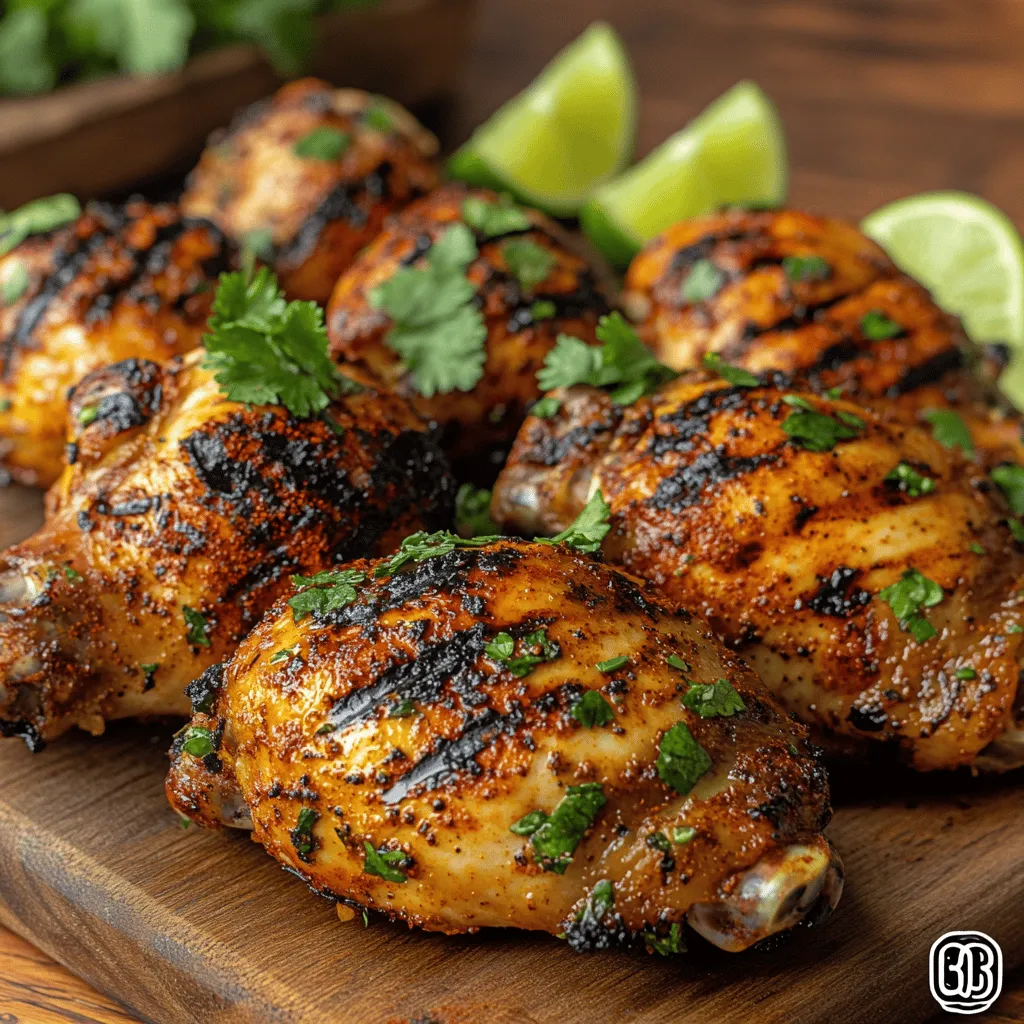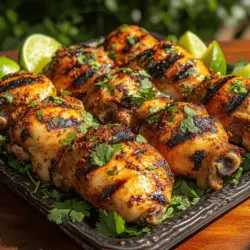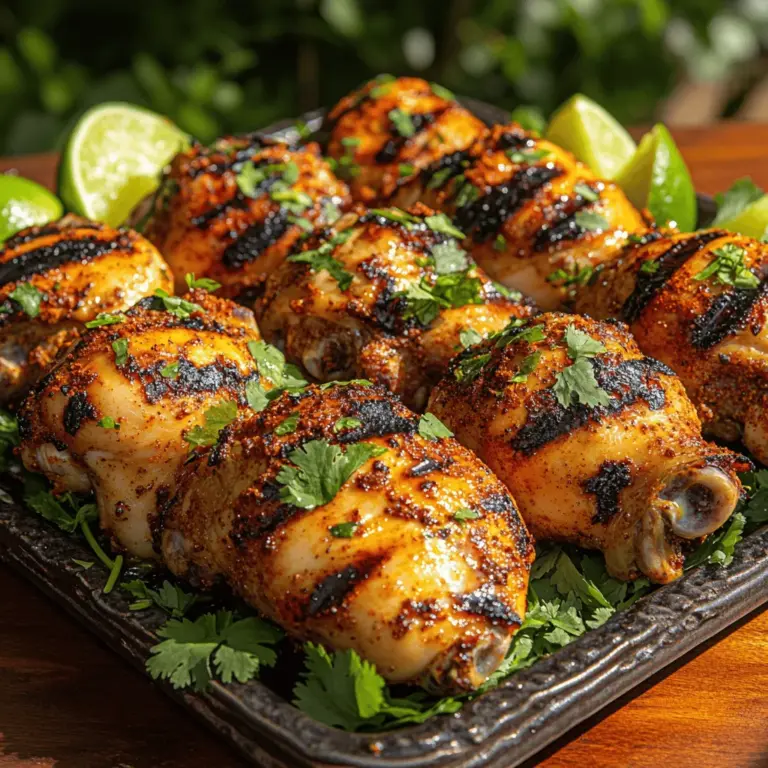Introduction
Peruvian cuisine is a vibrant tapestry of flavors, colors, and textures that reflect the rich cultural heritage of Peru. With influences from indigenous civilizations, Spanish colonization, and waves of immigration from Asia and Europe, Peruvian food offers a culinary journey that excites the palate. One dish that stands out in this diverse gastronomic landscape is grilled chicken, or “pollo a la brasa.” This dish is not only a staple in homes across Peru but also a beloved street food that embodies the essence of communal gatherings and family meals.
At the heart of this dish is the art of grilling, which in Peru is often a social event, bringing friends and families together to savor the smoky, charred flavors of perfectly cooked chicken. The importance of grilled chicken in Peruvian culture cannot be overstated; it is often accompanied by tangy sauces, such as the famous green chili sauce, and served alongside sides like fries and fresh salads.
The “Ultimate Peruvian Grilled Chicken” recipe elevates this classic dish by combining traditional marinating techniques with high-quality ingredients, resulting in an explosion of flavors that will leave you craving more. This recipe stands out for its unique marinade that infuses the chicken with a distinct taste, ensuring that every bite is succulent and packed with flavor. By using bone-in, skin-on chicken parts, we can achieve an optimal balance of juiciness and flavor, making this the ultimate grilled chicken experience.
Understanding the Ingredients
To create this ultimate dish, it’s essential to understand the key ingredients that contribute to its signature flavor. Each component plays a critical role in ensuring that the chicken is not only delicious but also embodies the authentic essence of Peruvian cuisine.
Chicken Thighs and Drumsticks
When it comes to choosing the right chicken for grilling, bone-in and skin-on thighs and drumsticks are the preferred options. The skin adds a layer of richness and helps to keep the meat moist during cooking, while the bones enhance the flavor through the natural juices they release. This combination ensures that the chicken remains juicy and tender, making every bite a delight.
Garlic
Garlic is a cornerstone of many cuisines, and in Peruvian cooking, it is especially revered for its ability to enhance and elevate flavors. In this recipe, garlic is a key player in the marinade, providing a savory depth that complements the spices and herbs perfectly. The aromatic qualities of fresh garlic will envelop the chicken, infusing it with a delightful fragrance as it grills.
Spices
The spice blend used in this recipe is what truly sets it apart and gives the chicken its distinctive character. Here’s a closer look at the essential spices:
– Cumin: Known for its earthy flavor and warm, nutty undertones, cumin has historical significance in Peru’s culinary landscape, often associated with traditional dishes. Its unique flavor profile adds depth and warmth to the marinade, making the chicken taste rich and complex.
– Paprika: This spice comes in different varieties, including sweet and smoked. For the ultimate grilled chicken, using a combination of both can enhance the flavor profile. Sweet paprika adds a gentle sweetness, while smoked paprika lends a subtle smokiness that pairs beautifully with the grilled chicken.
– Oregano: Fresh oregano is often preferred for its vibrant flavor, but dried oregano can also work in a pinch. Oregano adds a herby note that complements the other spices, creating a well-rounded flavor. For an authentic touch, using Peruvian oregano, if available, can enhance the dish further.
– Cayenne Pepper: This spice allows for customization of heat levels. Depending on your preference for spiciness, you can adjust the amount of cayenne pepper to achieve the desired kick. It adds a touch of warmth that balances the other flavors without overpowering them.
Lime
Citrus plays a crucial role in many marinades, and lime is no exception. Its bright acidity cuts through the richness of the chicken, adding a refreshing zing that enhances the overall flavor profile. The zest and juice of fresh lime bring a zesty brightness that elevates the dish, making it a perfect match for the smoky grilled chicken.
White Vinegar and Olive Oil
Both white vinegar and olive oil are essential for marinating the chicken. The acidity of white vinegar helps to tenderize the meat, while olive oil adds moisture and richness. Together, they create a marinade that penetrates the chicken, allowing the flavors to meld beautifully.
Fresh Cilantro and Dijon Mustard
Fresh cilantro adds a burst of freshness and a hint of earthiness that balances the spices. Its bright green color also adds visual appeal to the dish. Meanwhile, Dijon mustard contributes depth and a subtle tang that enhances the overall flavor of the marinade.
Importance of Using Fresh, Quality Ingredients
To achieve the ultimate flavor in your Peruvian grilled chicken, it is vital to use fresh, high-quality ingredients. The freshness of the herbs, spices, and chicken can make a significant difference in the overall taste of the dish. Locally sourced ingredients not only provide better flavor but also support sustainable cooking practices. Whenever possible, opt for organic or free-range chicken to ensure that you’re using the best quality meat for your recipe.
Preparing the Marinade
Now that we’ve explored the key ingredients that make this dish special, it’s time to focus on how to prepare the marinade. The marinade is the heart of the recipe, as it is what infuses the chicken with flavor and ensures it remains moist during cooking. Here’s a step-by-step guide on how to prepare it.
Step 1: Gather Your Ingredients
Before you begin, make sure you have all the ingredients ready. This includes:
– 4-5 bone-in, skin-on chicken thighs and drumsticks
– 4-6 cloves of fresh garlic
– 2 tablespoons of ground cumin
– 2 tablespoons of sweet paprika (and/or smoked paprika)
– 1 tablespoon of dried oregano (or 2 tablespoons of fresh oregano)
– 1 teaspoon of cayenne pepper (adjust to taste)
– Juice and zest of 2 limes
– 3 tablespoons of white vinegar
– 1/4 cup of olive oil
– 1/4 cup of chopped fresh cilantro
– 1 tablespoon of Dijon mustard
– Salt and pepper to taste
Step 2: Blend the Marinade
In a food processor or blender, combine the garlic, cumin, paprika, oregano, cayenne pepper, lime juice and zest, white vinegar, olive oil, cilantro, Dijon mustard, salt, and pepper. Blend until the mixture is smooth and well combined. You want to achieve a consistency that is thick enough to coat the chicken but not so thick that it won’t penetrate the meat.
Step 3: Taste and Adjust
Once the marinade is blended, taste it! This is your opportunity to adjust the flavors according to your preference. If you want more acidity, add a bit more lime juice or vinegar. For extra heat, increase the cayenne pepper. Adjust the salt and pepper as needed to ensure a well-balanced flavor.
Step 4: Marinate the Chicken
Place the chicken pieces in a large resealable plastic bag or a bowl. Pour the marinade over the chicken, ensuring that each piece is thoroughly coated. Seal the bag or cover the bowl, and refrigerate for at least 2 hours, but ideally overnight. The longer the chicken marinates, the more flavorful it will become, as the flavors will penetrate the meat.
The Science Behind Marinating
Marinating chicken serves several purposes. Firstly, it enhances flavor by allowing the spices and herbs to penetrate the meat. Secondly, the acidity from the lime juice and vinegar helps break down the proteins in the chicken, resulting in a more tender texture. Finally, the oil in the marinade helps to keep the chicken moist during the grilling process. By understanding the science behind marinating, you can appreciate how this simple step contributes to the overall success of the dish.
Marinating the Chicken
After allowing the chicken to marinate for the recommended time, you are now ready to grill! The marinating process not only builds flavor but also begins to transform the chicken into a tender and succulent centerpiece for your meal. As you prepare for grilling, ensure that you have all your grilling tools ready, including a preheated grill, tongs, and a meat thermometer for checking doneness.
In the next part of this article, we will delve into the grilling process, sharing tips for achieving perfectly cooked chicken and the delicious accompaniments that will complement your ultimate Peruvian grilled chicken dish. Stay tuned as we continue this culinary adventure!

Importance of Marinating Time and Techniques for Maximum Flavor Absorption
Marinating chicken is an essential step in preparing the Ultimate Peruvian Grilled Chicken, as it allows the flavors to penetrate the meat thoroughly. The right marination time can make a significant difference in taste and texture. Ideally, marinating the chicken for at least 4 hours is recommended to allow it to absorb the bold flavors of the marinade, which typically includes ingredients such as garlic, cumin, lime juice, and aji amarillo paste.
Tips on How to Properly Marinate Chicken
1. Use a Good Quality Sealable Bag or Container: A resealable plastic bag is ideal as it allows the marinade to coat all parts of the chicken evenly. If you prefer to use a bowl, make sure it is covered tightly with plastic wrap.
2. Ensure Even Coating: Before sealing the bag or covering the container, ensure the chicken is well-coated with the marinade. This can be done by gently massaging the marinade into the chicken.
3. Refrigerate During Marination: Always marinate chicken in the refrigerator to prevent bacterial growth. Never leave it at room temperature.
4. Turn Occasionally: If marinating for an extended period, turn the chicken occasionally to ensure even distribution of the marinade.
Benefits of Overnight Marination vs. Shorter Marination Times
While a minimum of 4 hours is advised, marinating overnight offers substantial benefits. An overnight soak allows the flavors to meld and infuse deeper into the chicken, enhancing its juiciness and flavor profile. For those short on time, even a 30-minute marinade can impart a noticeable taste difference compared to un-marinated chicken. However, it’s crucial not to exceed 24 hours, as overly marinated chicken can become mushy due to the acidity in the marinade.
Grilling Techniques
Prepping the Grill: Essential Steps for a Successful Grilling Experience
Preparing your grill is vital for achieving the perfect grilled chicken. Begin by cleaning the grill grates with a wire brush to remove any residue from previous cooks. Next, preheat the grill—whether gas or charcoal—so it reaches the desired cooking temperature. For gas grills, set the burners to medium-high heat. For charcoal, ensure the coals are evenly distributed and have turned white before placing the chicken on the grill.
Differences Between Gas and Charcoal Grilling Techniques
Gas grilling is often favored for its convenience and quick heat adjustments. It allows for precise temperature control and is generally easier to maintain, making it ideal for beginners. Charcoal grilling, on the other hand, provides a distinct smoky flavor that many grilling enthusiasts prefer. The key to charcoal grilling is to manage the airflow for temperature control, which can take some practice but rewards you with a unique taste profile.
Grilling the Chicken: Detailed Instructions for Achieving Perfect Results
1. Preheat Your Grill: Ensure your grill is hot enough, ideally between 400°F to 450°F, to achieve a good sear.
2. Oil the Grate: To prevent sticking, oil your grill grates using a cloth or paper towel dipped in vegetable oil, held with tongs.
3. Place Chicken on the Grill: Lay the marinated chicken on the grill and cook with the lid closed. This helps maintain temperature and cook the chicken evenly.
4. Cooking Time: Grill the chicken for approximately 6-7 minutes on one side before flipping. Cooking time will depend on the thickness of the chicken pieces.
5. Achieve a Beautiful Char: To get that appealing char, avoid moving the chicken around too much. Let it sit undisturbed to form grill marks.
Importance of Grill Temperature and Cooking Times
Maintaining consistent grill temperature is critical to prevent drying out the chicken. Use a grill thermometer to monitor the heat, and adjust the burners or airflow as needed. For chicken thighs, aim for an internal temperature of 165°F, while breasts can be pulled off a few degrees earlier since they will continue to cook while resting.
Techniques for Achieving a Beautiful Char and Crispy Skin
For that sought-after crispy skin, consider the following tips:
– Pat the Chicken Dry: Before marinating, patting the chicken dry removes excess moisture, leading to better browning.
– Use High Heat: Start grilling on high heat to sear the chicken, then move it to a cooler part of the grill to finish cooking.
– Baste for Flavor: Brush the chicken with additional marinade or oil while grilling to enhance flavor and moisture.
Checking for Doneness: How to Accurately Measure Internal Temperature
To ensure the chicken is perfectly cooked, invest in a good meat thermometer. Insert it into the thickest part of the chicken without touching the bone. The USDA recommends an internal temperature of 165°F for all poultry. Once reached, remove the chicken from the grill and allow it to rest.
Resting and Serving the Chicken
Importance of Resting the Chicken Post-Grilling to Retain Juices
Resting the chicken for about 5-10 minutes after grilling is crucial. This allows the juices to redistribute throughout the meat, resulting in a juicier and more flavorful dish. Cover the chicken loosely with aluminum foil during this time to keep it warm.
Ideas for Plating and Garnishing the Dish
When it comes to serving the Ultimate Peruvian Grilled Chicken, presentation is key. Consider serving the chicken on a large platter garnished with fresh cilantro, lime wedges, and thinly sliced red onions for a pop of color. You can also add grilled vegetables, such as bell peppers and zucchini, to enhance the dish visually and nutritionally.
Traditional Peruvian Sides to Complement the Chicken
To create an authentic Peruvian dining experience, pair your grilled chicken with traditional sides such as:
– Peruvian Rice: Flavored with cilantro, lime, and garlic, this rice dish complements the chicken beautifully.
– Papa a la Huancaína: Boiled potatoes topped with a creamy, spicy sauce made from aji amarillo, cheese, and milk.
– Ensalada Criolla: A refreshing salad of tomatoes, red onions, and cilantro dressed in lime juice.
Suggestions for Sauces or Dips That Enhance the Meal
No Peruvian meal is complete without a flavorful sauce. For this grilled chicken, consider serving:
– Aji Verde: A zesty, green sauce made from fresh cilantro, aji amarillo, lime juice, and mayonnaise that adds a spicy kick.
– Chimichurri: A classic Argentinian sauce that works wonders with grilled meats, made from parsley, garlic, vinegar, and olive oil.
Cultural Significance of Grilled Chicken in Peru
Overview of Grilled Chicken’s Role in Peruvian Culinary Traditions
Grilled chicken holds a special place in Peruvian cuisine, often featured in family gatherings and celebrations. Known as “Pollo a la Brasa,” this dish has garnered popularity far beyond Peru’s borders due to its unique flavors and cooking techniques.
Popular Variations of Grilled Chicken Found in Peru
In addition to the traditional Pollo a la Brasa, various regional variations exist, showcasing the diverse ingredients and cooking styles across Peru. Some variations utilize different marinades, such as those incorporating beer or a variety of local spices, while others may feature varying cooking methods, such as rotisserie grilling.
How This Recipe Reflects the Essence of Peruvian Cooking
The Ultimate Peruvian Grilled Chicken encapsulates the essence of Peruvian cooking by highlighting the use of fresh, local ingredients and vibrant flavors. This dish not only celebrates the country’s culinary traditions but also embodies the communal spirit of sharing meals with family and friends.
Conclusion
The Ultimate Peruvian Grilled Chicken is a culinary delight that brings the rich flavors of Peru right to your backyard. The combination of careful marination, expert grilling techniques, and thoughtful presentation makes this dish truly special. As you explore this recipe, take the opportunity to connect with the vibrant culture of Peru through its food.
Cooking and sharing authentic Peruvian dishes with loved ones not only fosters delicious memories but also enriches our understanding of diverse culinary heritages. So go ahead, fire up the grill, and enjoy the flavors of Peru in your home. Don’t forget to explore more Peruvian recipes to fully appreciate the country’s rich and diverse culinary landscape.


